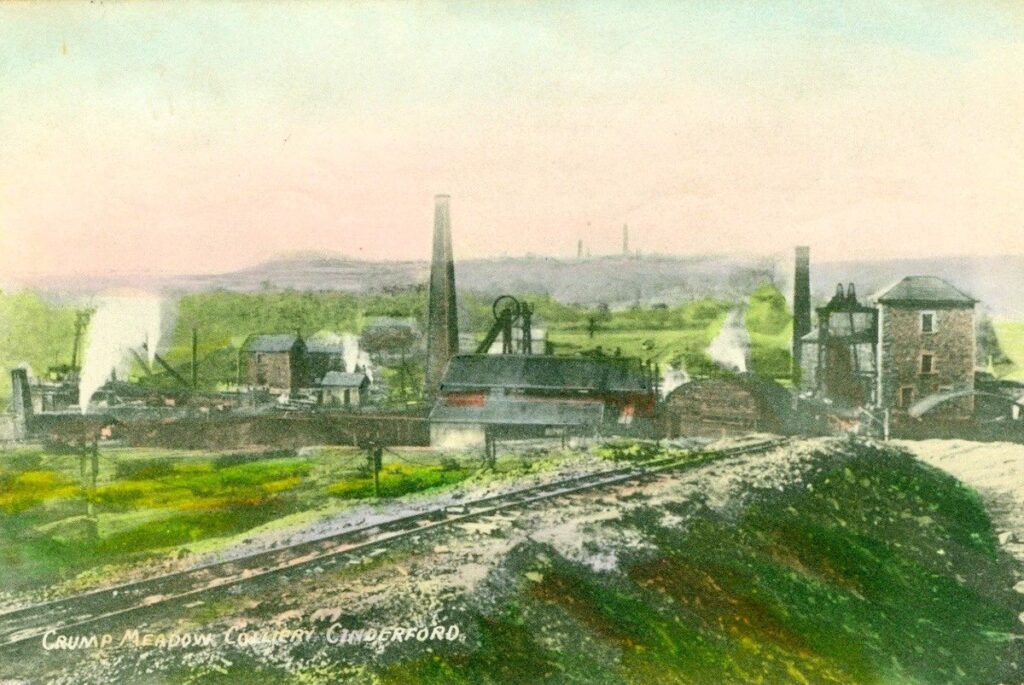81 Pits & Collieries Cinderford Parish.
Small Mines Cinderford & Steam Mills Coal.
1) Cinderford Bridge Pit (Wagstaff), 2) Prospect Pit, 3) Staple Pit, 4) Barleycorn Pit (Leather), 5) Spero Pit, 6) Paragon Pit, 7) Tease All Pit, 8) Links Delight Pit, 9) Bonnet Pit, 10) Guinea Pit, 11) True Blue, 12) Colly Pit, 13) Invention Pit, 14) Upper Bilson Pit, 15) Old Tormentor Pit, 16) Protector Pit, 17) Rocky on Hollyhill Pit, 18) Beddis Pit, 19) Painfelt Pit, 20) Never Fail Pit, 21) Fancy Pit, 22) Georges Folly Pit, 23) Georges New Folly Pit, 24) Tump Pit, 25) Trinity Pit, 26) Duck Pit, 27) Broadmoor Engine Pit, 28) Regulator Pit, 29) Tally Ho Pit, 30) Oak Pit, 31) Ditch Pit, 32) Watch Pit, 33) Stone Pit, 34) Whimsey Pit, 35) New Victory Pit, 36) Corner of the Hedge Pit, 37) Lucks All Pit, 38) Catch Can Pit, 39) Hit or Miss Pit, 40) Defender Pit, 41) Squib Pit, 42) Young Colliers Pit, 43) Fire Engine Pit,44) No Luck at All Pit, 45) Young Colliery, 46) Nofold Pit, 47) Protection Pit, 48) Dipple Pit, 49) Ready Money Pit, 50) Small Profit Pit, 51) Mount Pleasent Pit, 52) New Mount Pleasent Pit, 53) NewCastle Pit, 54) Whetstone Green Engin Pit, 55) Gain All Deep Engin Pit (later to become Crumpmeadow Colliery) 56) Crumps Regulation Pit, 57) Crumps Reslution Pit, 58) Crumps Elevation Pit, 59) Kemsely Water Pit, 60) Mousel Level Pit, 61) Winner Pit, 62) Woorgreen Pit, 63) Churchway Colliery, 64) Meadowcliff Colliery, 65) Bowson Colliery, 66) Addis Hill Colliery, 67) Collingwood Pit.
Larger Pits Cinderford & Steam Mills Coal.
1) Nelson Colliery, 2) Trafalger Colliery, 3) Hawkwell Colliery, 4) Northern United, 5) Crumpmeadow Colliery, 6) Foxes Bridge Colliery, 7) Haywood Colliery, 8) Great Bilson Colliery (Old Tom), 9) Speculation Colliery.
Iron Ore Collieries
1) Edgehills Colliery, 2) FairPlay Colliery, 3) St Annels Pit, 4) Dummers Level, 5) Inkermans Pit.
Cinderford Iron Works
In 1795 the first furnace in the forest to use coke for smelting iron-ore was erected half a mile north of cinderford bridge on a site now occupied by forest view residential park.
Ore was brought in to the works on mules backs from iron mines such as edge hills, coke was made at broadmoor and brought in along a small canal into the works, in november 1827 moses teague was to extend the iron works, he was joined by william montague and william bishop together they formed the 1st cinderford iron company.
They planned two furnaces with a powerful blast engine, finery forge & rolling mill, they planned to make 40 tons of tin plate per week, work began in the autumn of 1827 lack of finance delayed completion until october 1829,in 1835 teague introduced william allaway with his two sons stephen & william, they were joined by william crawshay a powerful welsh iron master, together with william montague & john pearce they formed the 2nd cinderford iron company.
In 1838 the works was sold to william crawshay & william allaway, after poor management by stephen allaway william crawshay’s second son henry was now in charge, the annual output in the two years up to 1840 was 12,000 tons, coal was supplied by edward protheroe & co from crumpmeadow, great bilson and winner collieries, as well as their heywood colliery the crawshay’s were now sinking their highly sucessful lightmoor colliery.
David mushet jr of coleford stated the cinderford cold blast iron is fetching a very high price in the market, the cinderford works now consisted of three blast furnaces, 28 workmens houses, counting house, smiths & carpenters shed, a range of stables that would later become the white chapel row, agents house & surgeons house.
By 1858 there were now four furnaces three of which were always in blast, these were 43ft high 14ft in extreame width, with a hearth of 6ft width, it was said that when these furnaces were loaded flames lept 100ft into the night sky, in 1862 henry crawshay purchest the entire interests of his parteners for £50,000 and was to become known as the iron king of the forest, in 1863 this iron works even had a book dedicated to it, written by h d hoskold of cinderford inventor of the miners transit theodolite.
Henry crawshay died in 1879 the following year his family were erecting two new furnaces on modern principle, cinderford had now become a town and a powerhouse of the industrial revolution, however cheap iron-ore from spain spelt out the fate of the works, and what was know as the last blowout took place on april 9th 1894 and the giant works closed for good.
War Memorial
the Cinderford War Memorial was designed by William Leah of Gloucester, the sculptor was J Swift of Doncaster. It was unveiled in a ceremony on 17th November 1923 by Field Marshal Sir John French, KP GCB OM GCVO KCMG, later the Earl of Ypres. The memorial consists of a high, four sided pedestal of grey Cornish granite, with stepped, offset corners in a Modern style, resting on a two-stepped platform of Portland stone. It is surmounted by a bronze figure of First World War infantry soldier, standing easy with rifle and fixed bayonet.








